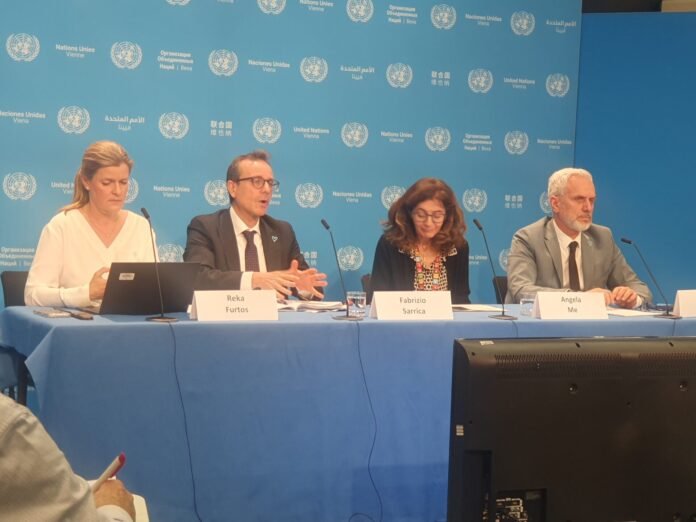Introduction to the 2024 UNODC Global Report
The 2024 Global Report on Trafficking in Persons, published by the United Nations Office on Drugs and Crime (UNODC), serves as a critical resource in understanding the current dynamics of human trafficking worldwide. The primary purpose of this comprehensive report is to synthesize data collected from various countries, providing invaluable insights into the patterns, trends, and evolving challenges posed by human trafficking in recent years. The significance of this research cannot be overstated, particularly in relation to its implications for global policymaking and the development of effective interventions.
The 2024 report emerges amid a backdrop of heightened vulnerability for many individuals and communities, primarily driven by socio-economic factors such as poverty, conflict, and climate change. These conditions have not only perpetuated the existing cycle of human trafficking but have also introduced new challenges that complicate efforts to combat this grave violation of human rights. As countries continue to navigate the complexities born from these crises, the report emphasizes the vital need for tailored responses that address the root causes of trafficking while also considering the diverse needs of affected populations.
Key Findings: Victim Statistics and Trends
The United Nations Office on Drugs and Crime (UNODC) 2024 Global Report reveals alarming statistics regarding human trafficking, emphasizing a significant rise in detected trafficking victims over recent years. From 2019 to 2022, there has been a striking 25 percent increase in reported cases. This upward trend is particularly concerning in the context of child victims, who represent a growing demographic within this crisis. Recent data indicates that children are increasingly vulnerable to various forms of exploitation, including forced labor and forced criminality, making targeted interventions more crucial than ever.
Demographic analysis presented in the report highlights a notable gender imbalance among trafficking victims. While both genders are affected, the trafficking of girls has seen a drastic increase. Reports suggest that girls account for a significant portion of those trafficked for sexual exploitation, an alarming trend that underscores the need for comprehensive protective measures. Conversely, an emerging concern is the rising vulnerability of boys, who are increasingly being trafficked for forced labor and involvement in criminal activities. This shift in dynamics calls for a reevaluation of strategies aimed at prevention and support, as both boys and girls face unique risks that must be addressed.
Additionally, the report provides insights into the age demographics of trafficking victims, indicating that younger individuals are being targeted more frequently. The increasing prevalence of minors among trafficking victims suggests a growing exploitation of youth, which necessitates urgent action from governments, non-governmental organizations, and communities. Understanding these trends is vital for formulating effective policies that safeguard potential victims and tackle the root causes of human trafficking.
These findings not only highlight the urgent need for increased awareness of human trafficking trends but also emphasize the importance of coordination among stakeholders to develop prevention measures tailored to the diverse profiles of victims.
Regional Insights: A Focus on Africa
The UNODC 2024 Global Report highlights critical human trafficking trends within Africa, shedding light on the distinct challenges faced in data collection across the continent. The limitations in statistics often stem from inadequate reporting mechanisms, insufficient resources, and political instability, which hinder the effective gathering of trafficking data. This lack of robust information can skew the understanding of trafficking patterns and trends, leaving authorities and organizations with an incomplete picture of the true scope of human trafficking in the region.
Trafficking destinations for African victims are predominantly urban centers, where economic opportunities appear more extensive, yet many fall prey to exploitation in areas such as domestic work, agriculture, and sex trade. The report underscores that, while many African nations are sources of trafficking, they also serve as transit and destination countries. Increasingly, internal displacement due to conflict, economic factors, and climate change has further exacerbated the trafficking situation. Populations displaced by environmental changes, such as droughts and flooding, are left vulnerable, leading to heightened risks of exploitation.
Child trafficking represents a particularly pressing challenge across the continent. The report reveals a worrying prevalence of children being trafficked for various forms of labor, sexual exploitation, and forced recruitment into armed groups. This underscores a broader trend in which traffickers exploit the vulnerabilities that arise from socioeconomic challenges. Additionally, trafficking dynamics often involve crossing national borders, complicated by inadequate law enforcement collaboration and regulatory discrepancies among neighboring states. Understanding these trafficking patterns is essential for developing effective interventions and policies that can mitigate the impact of these challenges on African populations.
Recommendations for Policy and Action
The UNODC 2024 Global Report on human trafficking presents a series of critical policy recommendations aimed at effectively combating this pervasive issue. Central to these recommendations is the urgent need to enhance victim identification and protection measures. This involves training law enforcement and frontline responders to recognize the signs of trafficking more efficiently and to understand the nuanced needs of victims. A victim-centric approach is essential to ensure that individuals receive the necessary care and support while they navigate through their recovery.
Moreover, the report emphasizes the significance of cross-border cooperation in combating human trafficking. Trafficking often transcends national boundaries, requiring a coordinated response among countries to facilitate the rescue of victims and bring perpetrators to justice. Establishing formal networks among law enforcement agencies, NGOs, and international organizations is vital to streamline efforts in preventing trafficking and ensuring victims can access the support they need regardless of their location. This cooperation should also extend to sharing intelligence and best practices to fortify global efforts against human trafficking.
Additionally, providing adequate support and services to survivors is paramount in the recovery process. The UNODC advocates for the development of comprehensive support systems, including legal aid, psychological counseling, and job training programs. By addressing the multifaceted needs of survivors, societies can help facilitate their reintegration and reduce the risk of re-trafficking. A holistic approach, as recommended, must address all forms of trafficking, considering the unique challenges faced by different populations, including women, children, and marginalized groups. By adopting these strategies, stakeholders can create a more effective framework to combat human trafficking on a global scale.






